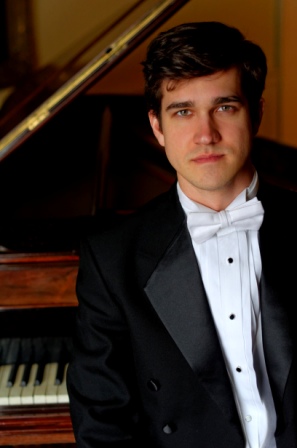Eastman in New York
Cahill Smith, piano
Weill Recital Hall at Carnegie Hall, New York, NY
March 14, 2015
Eastman School of Music, one of the country’s leading conservatories, under the series title “Eastman in New York” presented one of its fine doctoral graduates, Cahill Smith in a recital of standards and unusual repertoire, all enlivened by Smith’s uncommon musicality.
He is an affable young fellow, with a way of showing facially just where the music is going while he plays, what points it is making, and how his involvement fits with all that, and he does it in a non-obnoxious way, a rare talent. He also at all times gives the impression of creating “on the spot” rather than just parroting something that has been over-learned by rote. This is truly a gift.
His opening Scarlatti sonata, the F minor, K. 466, played with every advantage of the modern piano’s colors and shading, contained a lot of romantic rubato, but was nevertheless totally convincing in Mr. Smith’s hands. This segued directly into Scarlatti Cadences (1996), Sebastian Currier’s postmodern take on Scarlatti’s energy, including some direct appropriations. It was a great programming idea to have the mysterious cluster that begins the Currier follow the final note of the Scarlatti with no break. I felt as though some of Messiaen’s birds wandered into Currier’s world too. The coloring was beautiful from Mr. Smith.
Mozart’s Sonata in D Major, K. 311, finds the composer in an optimistic mood, and although we know how exposed Mozart is for the intrepid pianist, Mr. Smith illuminated every phrase affectionately and with sparkle, crisp runs, and stylish ornaments.
He then closed the first half of the recital with Liszt’s epic Vallée d’Obermann, from the “Swiss” year. In his charming verbal program notes, he said that the piece was new to him, and it sounded thus. I felt it really was best in those moments when he actually got a bit wild and almost out of control. That’s when the most fitting energy was applied, and at those times it was very exciting. Perhaps as he matures with the piece, he will find more mystery, more longing, more existential dread progressing to redemption. I suggest he re-analyze the motif as a “three-note descending” rather than the scale he mentioned. That way, he will discover just how it constantly refers to Obermann’s questioning “Que veux-je?/Que suis-je?” (What do I want? What am I?)
The entire second half was devoted to a special “cause” of Mr. Smith: the piano music of Nikolai Medtner, a Russian near-contemporary of Rachmaninoff whose music has been largely neglected in the rush to modernism (he worked in a largely tonal, conservative vein, but with great originality and touching emotion). He offered selections from Forgotten Melodies, Book 1, Op. 38 (I. Sonata Reminiscenza ,II. Danza graziosa, III. Danza festiva, VI. Canzona serenata, VII. Danza silvestra , Coda. Alla Reminiscenza). Here, Mr. Smith was in his element, revealing every twist and turn, every poignant repeat of the cyclic themes, with beautiful shimmering colors I haven’t heard since Gilels played the Sonata reminiscenza in Carnegie Hall in 1980. This was the most Medtner I’ve ever heard at one time, and I was wondering since he presented Op. 38, why did Mr. Smith leave out the fourth and fifth pieces? It would have made for a longer recital for sure, but no one was complaining.
After a rousing ovation, he did a “true” encore, and repeated the second Medtner piece, the Danza graziosa, with its hints of incipient ragtime à la Russe. It was even more finely shaded than the first time. Thanks to Eastman for providing a real program, and to Mr. Smith for writing his own program notes. Bravo.

